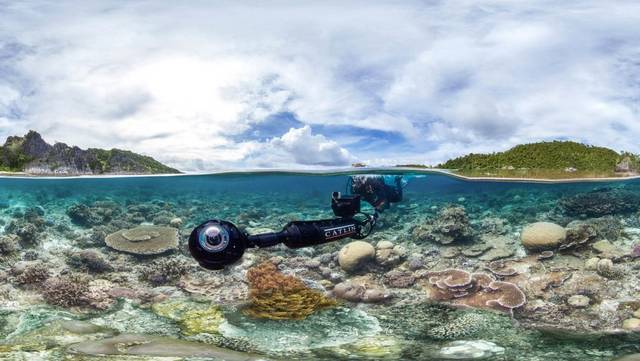Hawaii featured in Netflix climate-change film

COURTESY NETFLIX
“Chasing Coral” imparts an understanding of how humans rely on coral, with viewers made to care about how much of it is dying. What’s at stake is much more than a tourist attraction.
The documentary “Chasing Coral,” released today on Netflix, opens, appropriately enough, with images of coral — formations in various shapes and sizes, all of them stunning, charged with an array of colors so vivid they seem to pulsate. Other formations are a uniform hybrid of purple, green and gray. This isn’t stealth coral, or coral donning camouflage. It’s dead coral. Which is a problem.
The first voice we hear is that of Richard Vevers, a longtime diver and ocean enthusiast. He recalls the years he spent at a London advertising agency, where he was good at his job, and how he became convinced that what he was doing there was trivial. He decided to apply the communication skills he learned in his professional life to his passion, and created a company that both surveyed the world’s oceans and created “virtual dives” using special cameras.
The story of a company man who leaves the corporate world to devote his energies to something more groovy is not new. But Vevers was alarmed by something in his new line of work: coral “bleaching” and subsequent death, a phenomenon spurred by a two-degree rise in water temperature. The results are not just visually unpleasant, they’re ecologically catastrophic.
Vevers was not the first to notice. One climate scientist, who warned the world about coral bleaching in the early ’90s, recalls how he was dismissed as an alarmist. But Vevers was seized by the idea of documenting the phenomenon, which makes the movie a scientific suspense narrative, as a team devises the necessary equipment and sets out to reefs around the world to record the damage.
If you’re unschooled in marine biology, you see a coral reef as an unusual form of plant life. It isn’t. It’s animal life, and the movie provides a cogent explanation of how coral works. The macro photography of coral polyps, thousands of which protrude from any given coral formation, yields imagery that is more awe-inspiringly peculiar than anything in sci-fi cinema. And yet this is part of our real world.
In its explanation of how coral feeds, and how other forms of sea life feed on or around coral, the movie imparts an understanding of how humans rely on coral as well. So we’re made to care about how much of it is dying — what’s at stake is much more than an eye-popping attraction for diving tourists.
Don't miss out on what's happening!
Stay in touch with breaking news, as it happens, conveniently in your email inbox. It's FREE!
In the 2012 documentary “Chasing Ice,” director Jeff Orlowski followed a National Geographic photographer on a project to document how climate change was affecting Arctic glaciers. Vevers got in touch with Orlowski, who agreed to make a film chronicling the coral crisis. With its similar title, “Chasing Coral” is a kind of sequel to “Ice.”
“We hadn’t planned on making a series,” Orlowski said in a telephone interview. “Making ‘Chasing Ice’ really had awakened me to the urgency of the climate change problem, and this looked like an opportunity to tell a new story, and also one that had a very different visual aspect.”
The movie doesn’t lack for other interesting personalities. There’s Ruth Gates of the Hawaii Institute of Marine Biology, who helps Vevers conceptualize the setting up of time-lapse cameras in reefs for months at a time. There’s Australian reef explorer John Veron, known as Charlie, an elder statesman of the activist movement. Zackery Rago, a technician at a company where a special camera is being developed, is a self-described “coral nerd” who signs on to chronicle the bleaching in Australia’s Great Barrier Reef, a formation as long as the entire Eastern Seaboard of the United States. What he witnesses there and his reaction to it give the movie some emotional gravity.
At one point, members of Vevers’ team have to operate out of a barge that’s also a floating restaurant. Forced to dive daily and manually record the process of bleaching (a last-minute change in location has restricted the use of stationary, installed cameras), the researchers have to navigate a deck full of oblivious party people while an ecological disaster is happening below them.
“It just so happened that the barge was parked directly at a reef site in New Caledonia, and it gave great access; you could just take a boat out to it every day,” Orlowski said. “The shots of the partyers just happened to be captured by one of the cinematographers, Andrew Ackerman. It was only in retrospect that we saw the irony of it.”
Unlike “The Age of Consequences,” a recent climate-change documentary that looks at the crisis from a military perspective, “Chasing Coral,” despite serving up discouraging statistics, ends on several notes of hope, updating viewers on good work now being done by Vevers and others.
“We’re documenting the planet dying,” Orlowski told me. “It’s never going to be cheaper to repair the damage that’s been done. I am guardedly optimistic, mostly because of the changes in technology and the changes in mindset. The youth get it; the global audience gets it; and internationally, corporate, city, municipal forces get it. There’s a problem, we know what’s causing it, and we know what the solutions are, and we are at the tipping point of accepting those solutions.”




